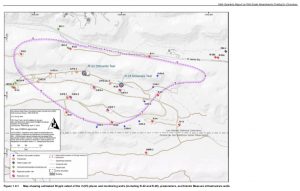
Comments to the Northern NM Citizens’ Advisory Board
By Scott Kovac, Nuclear Watch NM, July 24, 2019
Tremendous progress requires overall improvement, not just at one spot. A recent Environmental Management Los Alamos (EMLA) press release claimed “tremendous progress” with regards to the chromium (Cr) plume. Media stories then did their job and generalized that everything about the plume was getting better. This is the kind of public relations’ language that does not help to further the discussion on these complex issues.
“The interim measure has enabled us to make tremendous progress toward reducing the footprint of the chromium plume and keeping it within the LANL boundary,” Environmental Management Los Alamos (EMLA) Federal Cleanup Director Cheryl Rodriguez stated in the EMLA press release.
The plume may be held in place on the south side but that does not mean the plume is being held totally stable. EMLA stated that sampling from a monitoring well near that boundary (Regional Well R-50, which takes samples from the regional aquifer) in May 2019 showed a drop in concentrations of the contaminant, hexavalent chromium (Cr), from as high as 140 parts per billion (ppb) to 51.2 parts per billion, just above the state standard of 50 parts per billion.
A check at Intellus NM (the Lab’s public sampling database) shows R-50 was around the ~80 ppb level in Aug 2012 and rose to ~150 ppb in Oct 2017. This was all before any pumping. So there has been ongoing fluctuation. How can we be sure that this recent sampling is not just a fluctuation? The Cr in R-50 did just actually drop to 44 ppb in June 2019. Is it true that we are talking only about the concentration, in particular the parts per billion (ppb)? Is it true that the same amount of Cr may be in the area, but it’s been mixed with clean water to lower the concentration? Has the level of the top aquifer risen in that area? Is the Cr still there? How many gallons of clean water were pumped into the aquifer in order to lower the Cr concentration? How quickly will the higher concentration return after the pumping stops? These are examples of questions that the EMLA Communications Dept. should have also covered.
Meanwhile, R-61, which is the next monitoring well on the plume’s southern boundary to the northwest of R-50, showed the highest Cr sample since at least 2012. Samples from 2012 were in the mid-teens ppb, which is less than half of the 39 ppb reading from June 2019. Could this be a result of the interim measure pumping at CrIN-4, 5, &6 near R-50? Is the pumping around R-50 pushing Cr to R-61?
The Cr plume has been re-estimated larger around the new R-70 well while the plume on the southern boundary around R-50 is estimated to be shrinking. The R-70 well was drilled to better identify the true extent of the plume. Overall, the estimated size of the plume is probably larger than the 2017 estimates. EMLA can’t have in both ways – the plume is shrinking on the southern boundary because one monitoring well has had reduced Cr levels. The plume should be considered growing if R-70 shows 238 ppb at the NE boundary of the plume. What is the measure of a reduced Cr footprint?
There are still questions about its full extent and contamination levels. In 2017, a well that EMLA/N3B expected to be free of contamination (Crin-6) — and intended to use to inject clean water into the plume — was found to have more than five times the state limit of hexavalent chromium. As a result, the Lab redrew the shape of the plume. On the new map, a light purple is shaded to show the plume’s location, but the eastern edge is dotted with question marks. But what depth is the purple plume outline?
More questions revolve around the amendments experiment. Plugging of the treatment system influent bag filter and increased pressures observed at a Cr extraction well (CrEX-3) wellhead, suggest that one or both of the amendments test (sodium dithionite at R-42 and/or molasses at R-28) are responsible. The two amendments tests, which were an experiment to try to naturally convert the dangerous hexavalent Cr to the safe trivalent form, resulted in having to pause continuous pumping at CrEX-3 because the geochemistry of its water is causing plugging of influent bag filters at the treatment system.
Tremendous progress at one well (R-50) has been surrounded by setbacks at other wells, including R-28. EMLA/N3B has asked for extensions on two submittals to NMED to deal with the molasses around R-28. Fifteen years after the Cr was located under Mortandad Canyon, we are still trying to figure out what to do. Interim measures must not continue to drag out indefinitely.
The aim of press releases and these discussions should not be a public relations victory, but actual progress toward remediation.
More questions:
The monitoring well screens are all fixed depths, so we really don’t know what is going on above or below the screens. How deep is the plume at different locations?
The last sample that showed Cr in R-28 was Nov 2018. Is R-28 plugged?
CrIN-4, 5, &6 are now shown outside the plume but there are no recent samples to be found on Intellus NM.
